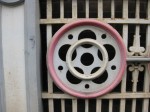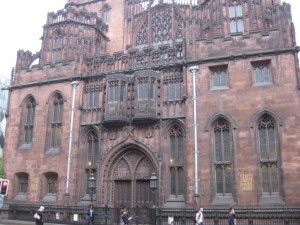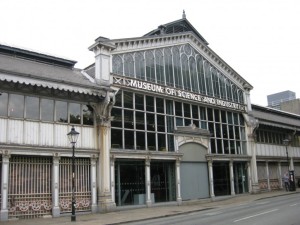The best thing about Manchester is that I walked around its streets by myself for a day and didn’t get lost. There was a moment when I realized I’d just gone in a circle, rounding back on the tombstones at St Ann’s church. How can I get lost with a map in hand? It’s about focus. Mine fuzzed at the tombstone tales of Jacobites, people and stories winning out over brick and mortar. .
There are, however, two places where stories and buildings come together in Manchester: the John Rylands Library, which opened in 1900, and the Museum of Science & Industry (MOSI). The red stone of the library stands out from the modern buildings on The Avenue (a sterile pedestrian mall) and those on Deansgate. If I did not feel that public libraries are a right and not a privilege, I might have been intimidated by its imposing style and its black iron fence. There’s a modern entranced glommed onto the side (2003). Popped in for a look. One can pass through quickly to the interesting bit. Going up well trodden stone stairs in search of the old reading room, I am stopped by an exhibition off the airy hallway.* This room leads to another with walls of wooden glass-fronted bookcases protecting leather-bound books. Murmurs of delight. And then the great hall of the reading room upstairs, high-ceilinged, stained glass windows, further lined with cases of old books. Statues of notable literary worthies guard reading alcoves, each of which contains a table and cases of books that are starting to look pretty valuable. What treasure trove is this? Here, too, was the exhibition “Echo and Narcissus,” mounted in glass and woodframe display cases (like jewellery or specimen cases): hand-mirrors with words engraved on them.
Would I have been as delighted with my find if I’d known the treasure trove was part of the Special Collections of the University of Manchester Library (since 1972)? The collection houses such texts as one of the Gutenberg bibles, an Egyptian Book of the Dead, and a scrap of papyrus recently discovered to have been a Christian charm written on the back of a tax receipt. Or over 250,000 printed volumes and over a million manuscripts and fragments. And the story: it was built by the wife of millionaire John Rylands as his memorial. Enriqueta Rylands insisted on the statues and the stained glass. She also bought some books to put in it, such as The Spencer Collection in 1892.
John Rylands made his fortune from textiles. Which brings us to the Museum of Science and Industry (MOSI), a museum that sprawls over former railway lands (Liverpool Road Station) in several buildings. The Textiles Gallery reminds us that Manchester used to be an industrial city, importing cotton and exporting finished fabric. The exhibition shows the progress of machines from hand-looms to power looms, with a hands-on section explaining what fabrics are made of, such as wood-based viscose and rayon. And explaining that the wealthy few profited by selling back to India and African countries the very fabric and designs those countries had invented, more cheaply than they could make them. Using cheap labour from Ireland (potato famine) and the north. Having admired gleaming steam engines, I spent far too much time in the history section of MOSI, reading about the impoverished textile workers, including children, who lived in airless housing with no such facilities as running water and were thus susceptible to cholera. (My marketing slogan for the empire: From Our Slum to Yours). Conditions of the labourers gave rise to social and political reform movements, including suffrage. The Pankhurst women came from Manchester.
Manchester’s industrial past shows itself in the cleaned-up city of today: canals and train tracks, the large spaces for the factories and the large brick buildings of warehouses. The spaciousness gives it a North American feel. Then there’s this oddity: Canada House, a packing warehouse that used a high-pressure hydraulic system to pack cotton bales. Its facade is not brick but terra cotta. I’ve not found out why it is called Canada House, but there are companion houses in India House and Asia House.
 *The two exhibitions on last week were “Communities in Communication: Languages and cultures in the Low Countries” and “Giving It Wigan,” about poet Norman Nicholson. Upcoming Exhibitions at The John Rylands Libarary.
*The two exhibitions on last week were “Communities in Communication: Languages and cultures in the Low Countries” and “Giving It Wigan,” about poet Norman Nicholson. Upcoming Exhibitions at The John Rylands Libarary.
The John Rylands Research Institute.
Textile Industry’s link with slavery (BBC)



When I was in Manchester, I somehow missed the Rylands library. Perhaps I shouldn’t be using the Good Beer Guide as my map.
LikeLike
Who knew Manchester held so much of interest? Thanks for sharing this, Debra. I wonder if Canada House is thus named because the products are destined for Canada? It seems unlikely, but alternatively, perhaps the raw materials come from Canada. That would explain the names of the other buildings as well. Or it could just have been the owner’s whimsy.
LikeLike
Hi Debra! I’m in the UK myself and thought I’d say hi. Great post, and wonderful stories in this blog!
LikeLike
Hi, Nerys, What are you in the UK for? Where?
LikeLike
Enjoyed this ramble through parts of Manchester (the interesting parts from the sound of it). Well done.
LikeLike